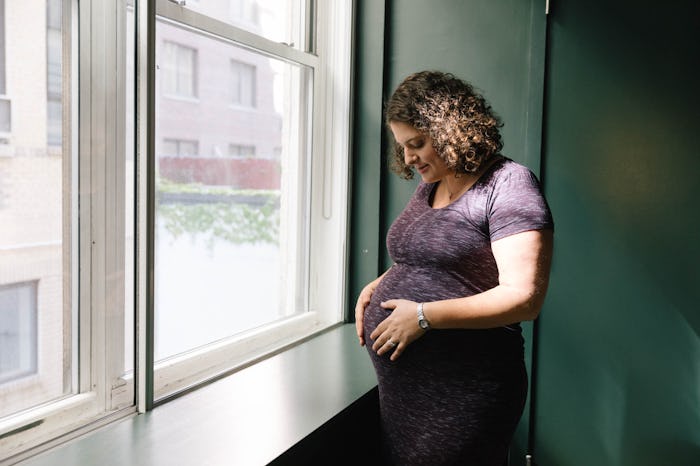Your doctor or midwife has been measuring your belly to assess fundal height, or the size of your uterus, at each of your monthly or bi-weekly appointments. And so far, your baby has appeared to be growing right on track. But now that you're at the end of your pregnancy, the numbers are less consistent and more confusing — no longer measuring as predictably as they once did. So what gives? Does fundal height change when baby drops? Or do you have legitimate reason to be concerned?
You almost certainly have no reason to worry, according to author and senior midwife Kathy Fray. "When your baby 'drops,' or descends into the pelvis in preparation for birth, the fundal height is reduced," the maternity consultant tells Romper. "This typically happens around 35 or 36 weeks for a first baby and slightly later with subsequent babies."
Reduced fundal height isn't the only indicator that baby has dropped, however, so make note of these additional signs as well. Fray says you can expect to breathe a bit easier since there is more room in the diaphragm — a welcome relief for most women — and you will feel the need to pee almost constantly. (You only thought that was true before.)
As Dr. Yvonne Butler Tobah explained on the Mayo Clinic website, fundal height is not always an accurate representation of fetal growth in the first place. For women who are obese, have a history of fibroids, or are carrying multiples, fundal height is not a reliable source for measurement. It can certainly still be performed and recorded at your check-ups, but if you have any of these conditions, your doctor or midwife will likely be taking your belly horizontal measurements with a grain of salt.
"Depending on the circumstances, your health care provider might recommend an ultrasound to determine what's causing the unusual measurements or more closely monitor your pregnancy," Tobah said. "But fundal height is only a tool for gauging fetal growth — it's not an exact science."
Fetal Growth Restriction is not something to take lightly, but if your baby is at risk, your health care provider will be ordering ultrasounds to assess the situation. A fundal height measurement that doesn't match up with gestational age might be a warning sign, according to BabyCenter, but it's oftentimes within the range of normal and is not cause for alarm.
If you're looking for signs of impending labor, the baby dropping (also known as "lightening") is unfortunately not one of them, as the Ask Dr. Sears website revealed. In fact, if you're a first time mama, your baby can drop two to four weeks before you actually deliver. Other people might say you look different, and you might notice that your breasts no longer touch the top of your belly, but that doesn't mean you're going into labor that day, or week (or even month!).
Second time mothers and beyond may not experience lightening until labor begins, because their pelvic muscles have already been stretched and know what to do. Some women don't feel a difference at all between their pre- and post- drop bumps, but other women say it feels like the baby is about to fall right out.
Towards the end of all three of my pregnancies I obsessed daily over whether or not the baby had dropped, even though I knew it didn't technically matter. Unlike typical medical observation, I didn't notice my first son dropping at all and could have sworn that my third one definitely did. But honestly, it didn't predict the timing of my labors either way. When it comes down to it, it's simply just another part of the waiting game.
